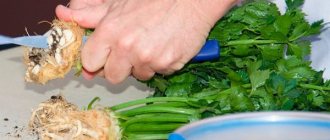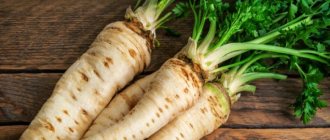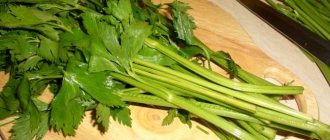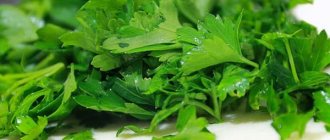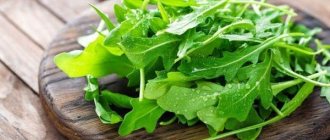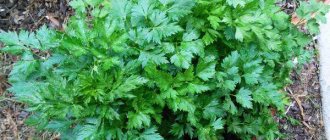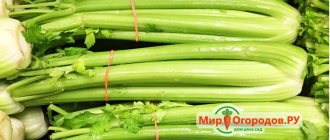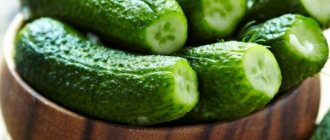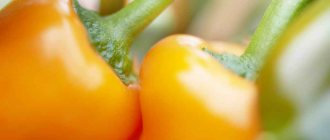Root parsley is a type of spicy herb that has a cone-shaped juicy root. The plant is cultivated everywhere, but is inferior in popularity to the leaf variety. The culture is not demanding on the soil; it grows on neutral, loose soil. It is responsive to watering, especially at the end of summer. All parts of the plant are used in cooking. Fragrant root vegetables are stored fresh for a long time. They can be dried and frozen for the winter.
Botanical description
Parsley is a spicy biennial plant from the Apiaceae family. The Latin name of the culture is Petroselinum crispum var. tuberosum. It is grown all over the world in open ground and greenhouses. There are two varieties of the plant: root and leaf. Both forms have a ribbed, erect stem. Their leaves are bright green with a smooth or corrugated surface. The leafy variety has a thin and branched root.
Root parsley is distinguished by a large, cone-shaped root crop that grows in the first year of its life cycle. It forms towards the end of summer. Spring shoots of the plant form a typical rosette of 30-40 thrice-dissected leaves. A ripe root crop grows up to 20-30 cm. Its outer part is white or yellowish-brown. The pulp is dense and pleasant to the taste.
In the second year, the plant produces a peduncle measuring 70-150 cm. Umbrella inflorescences form on it. The flowers are small, the petals are yellowish or white. The flowering period occurs in June-July. The fruits are oblong, compressed on the sides. Mature seeds are dark in color.
Information. The high content of essential oils in parsley seeds inhibits the emergence of seedlings.
Parsley: combination with other plants
Among the secrets of vegetable growing one can highlight proper crop rotation at a summer cottage. For every vegetable, there are best predecessors and bad neighbors with which the culture finds it difficult to get along. When you don’t think about this and plant plants as you please, it’s difficult to get a rich harvest of vegetables.
For parsley , as a representative of the Umbrella family, you need a plot where there were previously beds with onions, tomatoes, zucchini, and squash. Spicy herbs feel good in place of cabbage and cucumbers.
The herbaceous plant is often planted together with dill, cilantro or carrots. Beds with grass are located next to plantings of tomatoes and legumes.
Beds with aromatic herbs will provide excellent protection for strawberries and strawberries from pests.
Popular varieties
Root parsley is represented by mid- and late-ripening varieties. Of the early ones, only one variety, “Sugar,” is worth mentioning. Breeders do not spoil the diversity of the crop; 14 varieties of root parsley are included in the State Register. This indicator does not reflect the actual number of varieties. Not all options are included in the list. Interesting varieties are offered by breeders from the Czech Republic and Holland.
"Sugar"
Parsley is early ripening, the period before harvesting root crops is 80-98 days. A high-yielding development of domestic selection, proven over years of cultivation. Culture has been on the State Register since 1950. Characteristics:
- length – 20-30 cm;
- diameter – 3.7-6.3 cm;
- weight – 23-65 g.
The plant is resistant to cold, contains large amounts of vitamin C, carotene, and calcium. The total yield is 2.3-5.8 kg. The leaves are soft and similar in taste to leaf parsley. The roots are not intended for long-term storage; they are used for food in summer and autumn.
"Yadran"
Ripens late, after 193 days. The rosette of leaves is tall and spreading. Keeping quality is excellent, suitable for winter storage in the basement. The root does not branch and has an even shape. Characteristics:
- length – 20-22 cm;
- White color;
- surface is smooth.
Gardeners value the plant for its taste and resistance to disease.
"Harvest"
120-131 days pass before the mass harvest. The rosette is semi-erect, of medium height. The number of leaves is 11-24; they can be cut several times during the season. The greens are fragrant and rich in color. Characteristics:
- shape – conical, pointed;
- length – 20-30 cm;
- diameter – 4-7 cm;
- weight – 20-44 g;
- the surface color is greyish, the flesh is light yellow.
The variety is known for its high yield (3.6 kg/sq. m) and high content of vitamins A, B, C in the root. The plant is stored fresh and canned. Tolerates transportation well.
"Eagle"
The white, cone-shaped root vegetable is characterized by a sweetish taste and pleasant aroma. Its surface is white and smooth. The variety of Dutch selection is classified as mid-season in terms of ripening. At Igly, leaves and roots are used for cooking. The variety is recommended for growing greens at home. Characteristics:
- weight – up to 130 g;
- length – 25-30 cm;
- leaves grow back quickly after cutting.
Parsley is resistant to many diseases, cold and heat. Used for growing in greenhouses and open ground.
Storing parsley
Greens keep well for 2-3 months in refrigerators in bags made of thin plastic film. To do this, harvesting greenery in the fall should be carried out before the onset of stable frosts. Can be stored
Cut leaves with root vegetables. Leaves, cut by hand, are loosely placed in a box with plastic liners or in plastic bags or bags.
Before packaging, greens are pre-cooled, since uncooled products intensively release moisture, forming a lot of condensation inside the bag, which leads to spoilage and shortens the shelf life of the product. The thickness of the film for bags is 40-60 microns. To pack 300 g of leaves, use bags measuring 20 x 50 cm, for 1 kg - 35 x 50 cm.
The packages are placed vertically, loosely. Storage temperature is 0-1 °C. In such conditions, parsley can be stored for up to 3 months. The yield of marketable products during storage is 85-96%. At a temperature of 2-4°C, greens can be stored for 20-25 days.
Studies of the biochemical composition show that parsley, cut in the field in the fall and packed in plastic bags, by the end of storage contains 3.5 times more vitamin C and 1.4 times more carotene than greens from a greenhouse in winter
Growing and caring for root parsley
Spicy herbs are universal in choosing a place for growing; they are sown in open ground, greenhouses, and at home. The crop produces a bountiful harvest on loose soils fertilized with humus. It is advisable to prepare the planting site in the fall. The work includes digging, removing weeds, applying organic and mineral fertilizers. The bed should be well lit, protected from drafts, and have a pH level of 6-7.
Advice. Plant greens in place of potatoes, tomatoes, onions, and cabbage. Avoid areas where umbrella crops grow.
Seed preparation
Parsley seeds take 15-25 days to germinate. Soaking helps speed up the process. The most accessible option is to use water. Planting material is filled with liquid for 2 days. The water is changed twice a day. During this time, the seeds will swell and lose some of their essential oil. Adding a few drops of Epin or Zircon to the water will help stimulate natural processes. To disinfect the material and prevent diseases, the seeds are kept for half an hour in a solution of potassium permanganate.
Advice. Experienced gardeners have an express method for getting rid of essential oil. They place a gauze bag of seeds in vodka for 20-30 minutes.
Landing technology
The cold-resistant culture germinates at a temperature of 3-5°. Its planting begins in April. In the garden, grooves are made 1.5-2 cm deep. The distance between them is 15-20 cm. Before sowing, the grooves are watered. Due to low germination, the seeds are planted quite densely. It is advisable to mulch the surface of the bed to retain moisture. When growing, they use not only seed, but also seedling planting methods. In this case, there is no need to wait for seedlings.
Care
Beginning farmers are interested in how to grow large and juicy root crops? Plant care includes simple procedures:
- watering;
- weeding;
- loosening;
- fertilizing
Advice. The main problem when growing rooted greens is dense planting. Thin out the seedlings 2 times, the first time immediately after emergence, the second time after two weeks. The distance between neighboring plants should be 5-7 cm. During the dry period, watering is 20 liters per square meter. m. After precipitation and irrigation, the soil is loosened. The first feeding is carried out when 3-4 leaves appear.
The addition of urea is recommended. The second time, complex mineral fertilizer is used. In August, cutting of greenery stops.
Problems with growing
Why don't greens grow in the garden? Problems often begin after sowing. Gardeners wait for seedlings, which do not appear for 3-4 weeks. In desperation, other vegetables are planted in this place. But between them sprouts of parsley appear. There are several reasons for delayed germination:
- tightness of dry seeds;
- deep landing;
- the formation of an earthen crust on the surface through which fragile seedlings cannot break through;
- parsley cannot compete with weeds.
Problems with germination are associated with large amounts of essential oils. Rinsing in water or soaking in a vodka solution helps get rid of some of the chemical components.
Fertilizer for parsley
A bed with greens is fertilized at least twice. The first feeding is carried out in the phase of appearance of 2-3 true leaves. Before it is carried out, the rows are thinned out. You will need ammonium nitrate, superphosphates and potassium chloride, which can be replaced with ash. Dry granules dissolve in water and are applied under the root after watering. The greens are fed a second time after 2-3 weeks. Complex mineral fertilizers are used. One of the micronutrient supplements can be replaced with a solution of mullein (1:10) or bird droppings (1:15). Watering with nettle infusion will be useful.
Application
Spicy vegetables are used in cooking and are popular in dietary nutrition. The chemical composition allows the plant to be used in medicine and cosmetology.
Benefits and harms
The content of essential oils in the root of the plant is slightly lower than in the above-ground part, but it contains a whole range of useful substances:
- mineral salts;
- alimentary fiber;
- organic acids;
- vitamins A, B, C, E;
- proteins;
- carbohydrates;
- fats.
The listed composition determines the medicinal properties of the product. Carotene improves vision and skin condition, ascorbic acid strengthens the immune system, dietary fiber normalizes intestinal function. Parsley root is widely used in folk medicine. The plant helps get rid of inflammation of the mucous membranes and bad breath. Infusions and decoctions are prepared from it:
- Take 1 tbsp. l dry roots and pour 200 ml of boiling water. Leave for 30 minutes, take if there is excessive gas formation.
- Rubbing a decoction (50 g per 300 ml of water) into the head helps cope with hair loss.
- Juice made from fresh root vegetables helps cleanse blood vessels and improve heart function. The composition is diluted with water in a proportion of 15 ml per 100 ml, taken before meals.
Parsley infusion cleanses the liver of toxins, removes swelling, and reduces the acidity of gastric juice. The use of the product for medicinal purposes is permitted at any age.
Information. The spicy root vegetable prevents prostatitis and improves potency in men. In women, with regular use of the product, the menstrual cycle is normalized.
The fresh root is used in cosmetology to make masks. The procedure gives a whitening effect, pigment spots and freckles disappear. A mask with yolk and olive oil stimulates skin elasticity and smoothes out small wrinkles.
Contraindications to the use of parsley are:
- nephritis;
- cystitis;
- stomach ulcer in the acute stage;
- pregnancy – the plant affects the smooth muscles of the uterus;
- problems with calcium metabolism in the body.
The plant has diuretic properties; people with urolithiasis should consult a doctor before using it.
The main use of root vegetables in everyday life is cooking. It has a bittersweet taste that goes well with vegetables, meat and fish. The peeled root is added to salads. It is mixed with apples or vegetables in a vitamin dish. An original and low-calorie soup is made from the root vegetables of parsley and celery. The spice is used in home and industrial preservation.
Harvest and storage
Parsley is harvested depending on how long it grows. There are varieties that take 55-60 days to reach technical maturity, while for others 100 days is not enough. Greens are pruned throughout the entire growing season of the plant. It is frozen or dried to be added to food in winter. The yield per square meter ranges from 2 to 5 kilograms.
Autumn harvesting of vegetable roots ends no later than September 25. The fruits are cleared of soil and allowed time to dry. Then they are placed in basements or cellars with good ventilation and air temperature within 0 degrees. Root vegetables will be preserved better in wet sand.
The chopped or crushed roots are dried under a canopy and placed in glass jars. Sliced fruits are also frozen and used as a seasoning for dishes.
Author of the publication
offline 1 day
What to plant before and after parsley
To obtain a good harvest and to reduce the risk of pest attacks and the development of diseases on parsley, it is necessary to observe crop rotation. The planting site is changed every 3–4 years. The best predecessors for it will be cucumbers and other representatives of the pumpkin family, tomatoes, potatoes, onions, and white cabbage.
After the parsley, sow legumes, potatoes, tomatoes, garlic, and onions. You cannot sow crops of the umbelliferous family after it - dill, carrots, celery, fennel, coriander, cumin and others. For the same reason, experts advise not to combine planting dill and parsley; it is better to plant them separately from each other.
For the left or the right?
Root parsley overwinters well under snow
No. 45(286) dated November 17, 2011 [“Arguments of the Week”, prepared by Maria DUTOVA]
I am an inexperienced summer resident, but my vegetable bed this year was a success. On the advice of experienced neighbors on the right, I want to leave the parsley over the winter. But the neighbors on the left argue with the right; they consider this idea pointless and the result ineffective. Please answer me, will parsley survive the winter, is it worth leaving your beloved harvest in the cold? Irina Petrukhina, Elektrougli
P parsley is a biennial plant. In the first year in our middle zone, the plant forms a storage organ - a root crop . In the second year, parsley throws out a flower arrow, blooms, and the seeds ripen. Most varieties tolerate our winters well. And for a long time in Rus', part of the harvest was left for winter - for greens and seeds.
Today there are a large number of different varieties, both leisurely growing root varieties and early ripening leaf varieties. Root varieties grow slowly, gaining strength towards the end of summer. But they winter well under the snow ; the nutrients stored in the root crop allow the vegetable to survive frosts. Leaf varieties are specially bred for summer consumption. They grow much faster, forming a succulent rosette of leaves already at the beginning of summer. Leaf varieties do not form a long thick root, only a fibrous “beard” of thin roots. All the strength goes into the leaves. This means that leaf parsley does not overwinter well , leaving it in the garden is useless.
Probably, a dispute between neighbors on the right and left arose around the capabilities of different varieties of parsley. And all your neighbors are right in their own way. If you have grown good root vegetables, be sure to leave part of the crop to winter . Do not trim the leaves. Remove only diseased and dried ones. A blanket of snow will reliably protect the plant. The leaves will remain green and juicy. Throughout the winter, you can shovel snow and pick off leaves. If there is not enough snow, throw it on the garden bed.
In the spring, after the snow melts, do not dig up the crops. Cut fresh, early, healthy greens. It will help you survive spring vitamin deficiency while waiting for winter crops of green crops to sprout.
If you have planted non-hybrid varieties , then “allow” the parsley to expel the flower shoot and bloom. The leaves will become tough and tasteless, but by the end of summer the seeds will ripen. Collect them and get excellent seed with maximum germination and winter hardiness . Good luck.
I am an inexperienced summer resident, but my vegetable bed this year was a success. On the advice of experienced neighbors on the right, I want to leave the parsley over the winter. But the neighbors on the left argue with the right; they consider this idea pointless and the result ineffective. Please answer me, will parsley survive the winter, is it worth leaving your beloved harvest in the cold? Irina Petrukhina, Elektrougli
Growing parsley at home in winter
To enjoy green vitamins all year round, parsley can be grown on a windowsill in winter.
To do this in the fall, you need to dig up 2-3 parsley roots from the garden bed and plant them in flower boxes. At home, parsley grows well in nutritious soil with regular watering. Within 5–6 weeks from the moment of planting, parsley forms a lush rosette of fragrant leaves.
At the end of winter, you can sow parsley with seeds at home. It is best to choose varieties of curly parsley for these purposes, since it grows quickly and produces the lushest greens. The seeds are soaked before sowing. The box with the crops is placed on a well-lit windowsill. After emergence, the sprouts need to be thinned out and grown until full foliage appears.
Preparing the beds
Leaf and root parsley are extremely demanding both in terms of soil type and its fertility. On heavy, clayey soils that tend to retain water on the surface, the plant will develop poorly. Root parsley does not produce a harvest at all - its roots, breaking through the clay, become thinner, bent, and then acquire a dirty brown color. Leaf parsley reacts in such conditions by reducing the volume of the tops, poor growth, and its leaves become pale green.
To successfully grow parsley, the soil must be loose, ideally sandy loam or loamy soil. Choose a sunny place, protected from cold northern winds, without stagnant melt and rain water. The bed is prepared in the place where potatoes or tomatoes were previously grown: here the parsley will hurt less and grow better.
If the soil is clayey and not fertile, then add the following substances per square meter:
- humus - half a bucket;
- sand - 2 kg;
- superphosphate - 1 tablespoon;
- potassium sulfate - 1 tablespoon;
- half a liter jar of wood ash.
You can apply urea from nitrogen fertilizers, but about 2 weeks before sowing parsley.
The bed is dug up, the roots of perennial weeds, debris, and large stones are removed. It is desirable that the soil be loose, so the lumps are carefully broken up. The surface of the bed is leveled and furrows are cut at a distance of 10-12 cm from each other and a depth of 1 cm. The day before sowing, the furrows are shed with a weak solution of potassium permanganate at the rate of 3 l/m2.
It is advisable to make the bed several weeks before sowing so that the soil has time to settle. Otherwise, it will settle along with the seeds and they will not be able to sprout, or seedlings will appear much later.
How to grow leaf parsley in an apartment?
Very simple. To begin with, choose a suitable place, for example, an insulated balcony or window sill. Plants should have enough sunlight throughout the day. Then decide on the type of parsley.
Take plastic containers or any other container suitable for your needs, fill it with soil (chernozem, humus, potassium), make small depressions in the soil and feel free to sow the seeds. Afterwards, water, only carefully, avoiding washing away the soil with the seeds.
You can also plant root parsley; just stick the parsley root into the already prepared soil and water it. Fertilize once a month with ammonium nitrate and superphosphate.
Collecting leaf parsley seeds
In the first year of growth, parsley does not produce seeds. If you decide to collect seeds at the end of the growing season, you need to choose a strong, healthy plant. The seeds from it will be large and of high quality.
It is better to collect seeds when they acquire a dark color; if collected early, the seeds will have less chance of sprouting together. Sort the seeds, giving preference to the larger ones.
To avoid damaging the seed capsule, collect not by hand, but by cutting off the seed caps. Then shake out the seed caps into a bag.
To ripen the seeds, place them in the sun for two days. Spread it on the windowsill in a thin layer and keep it in a fabric or paper bag until sowing.
Diseases and pests
- Alternaria blight (black rot) - spots appear on the leaves of parsley and the growth of the bush stops. Excessive watering and a cramped pot contribute to the development of the disease. Treatment: try a decoction of onion peels.
- Powdery mildew - a white powdery coating with black spots appears on the leaves, cuttings and stems of the plant, which is why the parsley becomes fragile, the juice disappears and the taste is lost. Treatment: spray with cooled wormwood decoction (100 g of dry wormwood per 400 ml of boiled water, bring to a boil and simmer for 5 minutes) or strong tincture of garlic.
- White rot - a white mycelium forms on the surface of the plant, on which black sclerotia of the fungus subsequently form. The tissue softens, turns brown, and the parsley completely rots. Treatment: thermal disinfection of seeds at a temperature of 45-50° for 30 minutes; spraying second-year plants with 1% Bordeaux mixture from the moment the first signs of disease appear; Sprinkling the affected tissues with crushed coal or chalk.
- Stem nematode is a small whitish worm; larvae and adults feed on plant sap, causing them to bend and stunt growth. Treatment: thermal disinfection of seeds and sets in heated water at a temperature of 45-50° for 10-15 minutes. Sowing only with healthy seed material. Treatment of diseased plants with wormwood-tobacco or garlic infusions.
- The carrot fly is an insect 4-5 mm long, with a black abdomen that has a shine and a greenish tint, a brown head and yellowish legs, and settles in places with high humidity. Parsley lags behind in growth, its leaves acquire a reddish-purple color, turn yellow and dry out. Treatment: treat the parsley with a special solution (10 liters of water + 1 tablespoon of ground black or red pepper + 1 teaspoon of liquid soap; 1 liter per 1 sq.m.) You can also sprinkle pepper or wood ash between the parsley crops.
Good luck!
Sowing time
Pre-winter sowing at the end of October, before the onset of frost and snow . Here you need to ensure that the plants do not freeze. Summer sowing of parsley in June-July is suitable for its sale in the next season. Here the parsley will often have to be protected from the bright sun with shields.
Attention! The most optimal time for sowing is early spring: in April, when the threat of severe frosts subsides.
When sowing in spring, greens can be harvested throughout the growing season. Leaf parsley prefers sunny places with breathable, fertile soils. The only variety that tolerates shade well is “Bogatyr” .
The best predecessors for leaf parsley are potatoes, cabbage, beets, onions, tomatoes and cucumbers.
